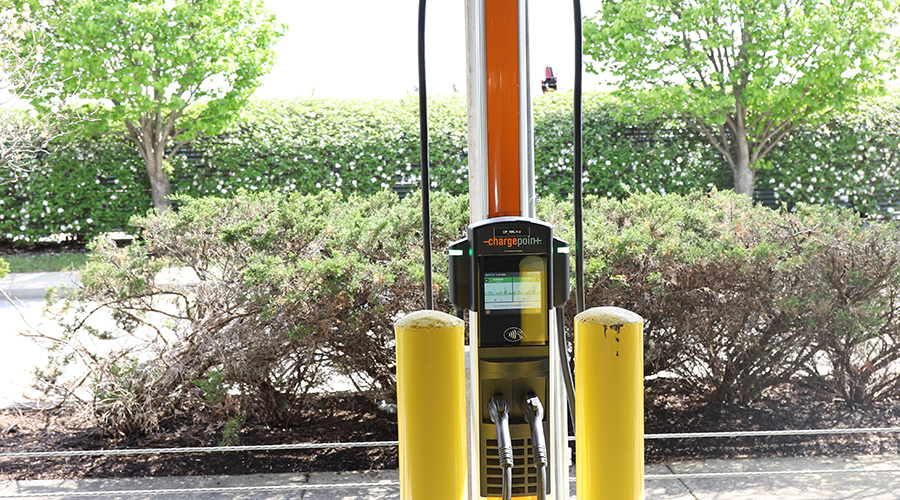How IFC Tracks Energy Usage and Efficiency
To keep on top of customer service, Pearlman's team runs a facilities help desk that provides service support for occupants. He uses this help desk as he does most other aspects of the operation: to gather and analyze data with an eye on improving.
"From a data-driven perspective, complaint calls aren't bad," Pearlman says. "Conventional wisdom is that you're not going to make everyone happy all the time. But we can tune the building to keep as many people as happy as possible."
Nowhere does this strategy stand out more than the continuous experiment Pearlman and his team run on temperature setpoints. In addition to its LEED-EBOM Platinum certification, IFC headquarters has also earned a 94 Energy Star score. That's high enough that Pearlman has to be rather exacting about improvement. So, working closely with his engineer and the building's automation system, Pearlman lowers or raises (depending on season) the setpoint by half a degree in different areas. Then they carefully monitor hot/cold complaint calls to the help desk, and if the number doesn't significantly exceed the normal threshold, which has been set after accumulating 10 years of complaint call data, they leave the setpoint where it is.
"We keep the changes small and make them over the weekend," says Chris Potkay, chief engineer with Brandywine Realty Trust, IFC's property manager that works closely with Pearlman's onsite facility team. "Our thinking is that people come back on Monday after two days removed and it's harder to notice the slight temperature difference." In fiscal year 2010, this strategy resulted in savings of more than $42,000 on energy costs.
Another highly successful energy-saving experiment the team ran involved lighting levels. Each workstation contained two rows of uplighting. Pearlman and his team removed one of the two rows of lighting in various spots in the building — close to and away from windows — at different times of the year, and again tracked complaint calls. When there were very few complaint calls in the experimental areas, the team removed half the lamps all over the building.
"We still received very, very few complaints," he says. "And we saved a huge amount of electricity." In fiscal year 2010, that amount (about 450,000 kWh) calculated out to more than $60,000 in savings.
IFC's engineering team has worked to tune the building automation system (BAS) to stagger start-ups and shutdowns in the morning and evening to save even more energy. Additionally, with the approval of management, the building is no longer conditioned on weekends. If employees want to work on Saturday or Sunday, they have to put in a request with 24 hours notice, and their department is then charged back for the electricity needed to condition the space they use. Cutting those weekend hours saved $71,400 on energy costs in fiscal year 2010 (July 1, 2009 — June 30, 2010).
Overall, between the 2003 and 2008 fiscal years, the team saved 17 percent on energy. Between fiscal years 2008 and 2010, they saved another 24 percent — a rather significant accomplishment considering the huge increase in occupancy.
Communicating Sustainability
Spelling out these and other environmental successes to both upper managers and the building's occupants has been an important priority for Pearlman and his team. Last year, Pearlman penned a Smart Lesson — basically an intra-office newsletter IFC employees write to share expertise — titled "From Burdens to Brownie Points: From ‘Have To's' to ‘Want To's' to Combat Climate Change." The document explains all of the team's initiatives that contribute to the company's goal of being totally carbon neutral, which it has been at its headquarters building since 2006.
IFC's Footprint Group has been a huge help to Pearlman's energy efficiency initiatives. The group formed in 2005 to monitor performance, implement strategies, promote behavioral change, and report on activities related to the carbon neutrality goal. Just this year, that group was placed under the purview of the facilities team, which Casqueiro calls a "big win" for facilities. "They are instrumental in pushing us to be green," she says. The biggest reason the Footprint Group was put under the purview of the facilities team is that many of the big wins in the area of corporate sustainability relate to facilities, including electricity, which represents a big portion of the company's emissions profile — 39 percent in fiscal year 2009. (Air travel is the biggest piece, at 58 percent.)
The Footprint Group uses the building's LEED-EBOM Platinum certification as a jumping-off point to run what it calls "10-Minute Tune Ups" with each IFC employee. It recruits volunteers — Footprint Champions — in each department to go over a list of questions with each employee. The 10-Minute Tune Up helps educate employees about what they can do to contribute in areas like using public transportation, recycling and simply turning computers off to contribute to the company's goals.
IFC won the 2010 District of Columbia Mayor's Environmental Excellence Award for its sustainability and carbon neutrality success. Casqueiro says the award has been a great boost to the respect her team has earned with senior management. So has the LEED-EBOM Platinum certification, an ongoing project which Pearlman calls "a tool for creating credibility."
Another benefit of LEED is that, because it requires standardized facility management practices, including measurement and verification, staying the course on LEED goals helps Pearlman and his team keep a handle on the sheer volume of data it's possible to amass managing a 1.1-million-square-foot facility.
Pearlman constantly emphasizes the notion that only data that can be analyzed efficiently and with a particular end in mind is useful data. Using that data to manage is one of the most important lessons Pearlman says he's learned in his 12 years at IFC: "From early in my career, I learned the value of data to leverage decisions. If I can't measure something, I have no idea how I'm doing."
RUNNING THE NUMBERS
Anatomy of a $65 Million Cost Avoidance
Seats added since 2003: 845
In leased space, Pearlman assumes a 300 square foot per employee standard.
Lease rates in the downtown Washington area in 2003 were about $45 per square foot. Currently, they're about $75 per square foot.
Based on the average lease rate each year, the number of employees added each year, and the total square footage per year that would've been needed, Pearlman calculated how much money the company would've spent on rent.
For instance, if the company had leased 33,000 square feet (enough to house 110 employees) at $45 per square foot per year for the past eight years, that space would have cost $11.9 million, not correcting for inflation. Continuing a year-by-year simulation to account for all the employee additions, Pearlman calculated the company would've spent $85 million in rent between 2003 and today to house all its new employees.
Pearlman and his team have spent about $13 million on in-house compression, reorganization and other related work to fit the 845 seats in the headquarters building.
That means a $72 million savings. But to make sure his assumptions and calculations are conservative, he lowered his estimate by 10 percent, or $7.2 million — yielding an approximate eight-year total of costs avoided of $64.8 million.
— Greg Zimmerman
|
Related Topics:














